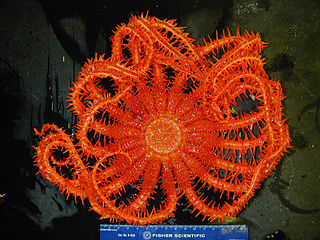
The Valvatida are an order of starfish in the class Asteroidea, which contains 695 species in 172 genera in 17 families.

The Echinasteridae are a family of starfish in the monotypic order Spinulosida. The family includes eight genera and about 133 species found on the seabed in various habitats around the world.

The Asterinidae are a large family of sea stars in the order Valvatida.

Patiriella is a genus of sea stars of the family Asterinidae. Many species formerly included in this genus have been transferred to other genera. They are commonly known as carpet sea stars.

Meridiastra calcar, formerly classified as Patiriella calcar, is a species of sea star in the family Asterinidae. It is endemic to Australia. It is commonly known as carpet sea star, cushion sea star, or eight-armed sea star.

Goniasteridae constitute the largest family of sea stars, included in the order Valvatida. They are mostly deep-dwelling species, but the family also include several colorful shallow tropical species.

Meridiastra mortenseni is a sea star of the family Asterinidae. It is endemic to New Zealand. Described as Patiriella mortenseni in 2002, it is named after T. Mortensen, who recorded it as distinct from Patiriella regularis, the New Zealand common cushion star, in 1925. According to genetic evidence, P. mortenseni was moved from the Patiriella genus to Meridiastra in 2004.

The Brisingids are deep-sea-dwelling starfish in the order Brisingida.

Callopatiria is a genus of starfish of the family Asterinidae. The genus is found in shallow waters off South Africa, down to a depth of about 82 m (269 ft).
Xyloplax medusiformis is a sea daisy, a member of an unusual group of marine taxa belonging to the phylum Echinodermata. It is found at bathyal depths in waters around New Zealand. It was first described in 1986 by Baker, Rowe and Clark and is the type taxon of the genus Xyloplax. Its generic name derives from the Greek "xylo" meaning wood and its specific name was chosen because its morphology superficially resembles that of a cnidarian medusa.

Cryptasterina pentagona is a species of starfish in the family Asterinidae. It is found in shallow waters in north eastern Australia. Its life cycle includes the release of large-yolked eggs and the development of planktonic larvae which is in contrast to the very similar Cryptasterina hystera which is viviparous. The two appear to have diverged from a common ancestral line only a few thousand years ago.

The Brisingidae are a family of starfish found only in the deep sea. They inhabit both the Atlantic and Pacific Oceans at abyssal depths, and also occur in the Southern Ocean and around Antarctica at slightly shallower depths.

The Freyellidae are a family of deep-sea-dwelling starfish. It is one of two families in the order Brisingida. The majority of species in this family are found in Antarctic waters and near Australia. Other species have been found near New Zealand and the United States.

The Zoroasteridae are one of three families of Asteroidea in the order Forcipulatida. It contains seven living genera and one extinct genus.

Nepanthia is a genus of starfish of the family Asterinidae. Members of the genus have four to seven rays and are found in the eastern Pacific Ocean, ranging from Burma and Indonesia to Australia.

Astroceramus is a genus of abyssal sea stars in the family Goniasteridae.

Disasterina is a genus of sea stars of the family Asterinidae. The genus occurs in the Indian and western Pacific Oceans.

Parvulastra is a genus of starfish belonging to the family Asterinidae. The species of this genus are found in Southern Hemisphere.

Rathbunaster is a monospecific genus of sea stars in the family Asteriidae. The genus name was given by Walter Kenrick Fisher to honor the starfish biologist Richard Rathbun of the Smithsonian Institution. He originally ranged this genus under the family Pycnopididae, synonymous with Asteriidae.

Meridiastra is a genus of star fish in the family Asterinidae. The genus is found in the Indian and Pacific Oceans, with most records from the waters around Australia. They occur in shallow waters down to a depth of about 59 m (194 ft). Meridiastra are morphologically similar to the Atlantic genus Asterina. They are also phylogenetically close and possibly sister genera.


















